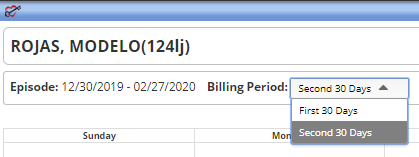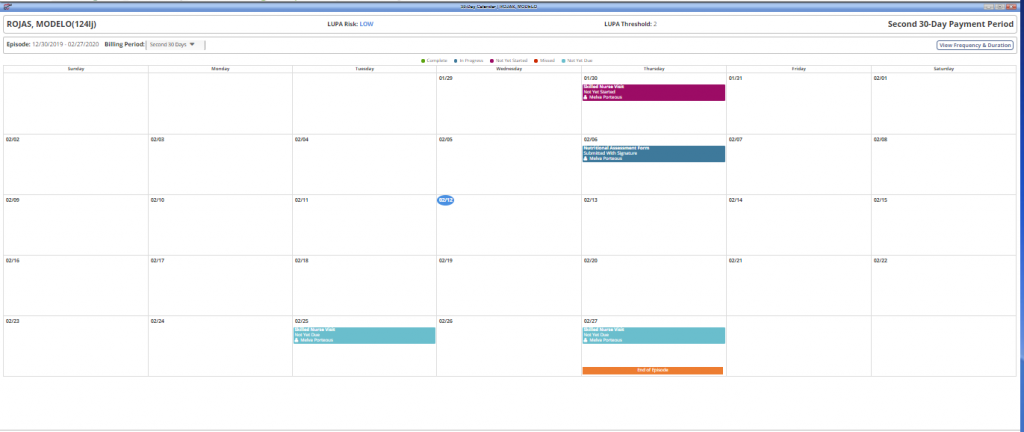This feature enables agencies to increase the proficiency of clinical operations under PDGM. The PDGM 30-Day Calendar provides real-time visit and assessment statuses for patients with OASIS assessments and insurance payers that follow PDGM (i.e., Medicare). It enables clinical managers to quickly determine actions required to protect revenue due to LUPA risks, missed visits, and visits not yet started. Agencies can use the PDGM 30-Day Calendar to make timely decisions to improve clinical and financial outcomes.
The PDGM 30-Day Calendar is accessible to anyone with scheduling permissions and access to the Schedule Center.
To access the PDGM 30-Day Calendar, navigate to the Patient Charts and select PDGM Dashboard. Patients tab ➜ Patient Charts ➜ PDGM Dashboard
(The PDGM Dashboard can also be accessed through the PDGM Center when a patient is selected from the list of sorted patients. PDGM tab ➜ PDGM Center)
The calendar view is set based on the agency’s Medicare week for the current billing period. Medicare week information can be accessed and updated in the Billing tab of Company Setup. Admin tab ➜ Company Setup ➜ Billing tab ➜ Billing section ➜ Medicare Week
The PDGM 30-Day Calendar can also be accessed through the Schedule Center. Schedule tab ➜ Schedule Center
In the Schedule Center, the PDGM 30-Day Calendar defaults to the current billing period with the current date highlighted. Users can toggle between the first and second 30-day periods to view the respective calendars.

The calendar is color-coded based on visit statuses:

The name and contact information of the assigned user is shown for each scheduled visit.
In the last five days of the first 30-day period, the calendar will include a note indicating Care Period Decision Due to alert the user to the pending care period decision.
In the last five days of the second 30-day period, the calendar will include a note indicating End of Episode Decision Due to alert the user to the pending end-of-episode decision.
If a PT, OT, or ST Assessment/Re-Eval was completed during the billing period, a note indicating PT/OT/ST Reassessment Due will appear 30 days after the visit date. If a Therapy Discharge is completed, the Therapy Reassessment will fall off the calendar.

The PDGM 30-Day Calendar also includes sections displaying LUPA Risk Alert and Frequency and Duration data for each discipline:
The Low Utilization Payment Adjustment (LUPA) Risk Alert data is based on Home Health Gold LUPA threshold levels for each 30-day billing period. The user is alerted to low LUPA risks, high LUPA risks, and LUPAs.
If there are any missed visits, the total number of missed visits for all disciplines is subtracted from the total discipline visit count for the current 30-day period which may impact the LUPA threshold. If there are any PRN visits, they will be added to the total visit count recalculating the LUPA risk.

The PDGM 30-Day Calendar displays the frequency and duration for each ordered discipline. Updates flow to the calendar as episode frequencies are adjusted.

Updated on 2/14/2020